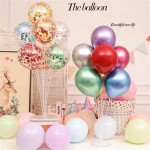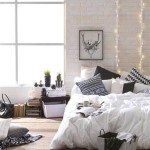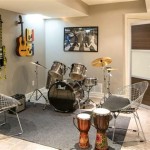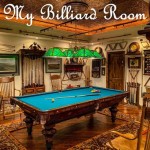How To Decorate a Big Wall in a Living Room
A large, blank wall in a living room presents both a challenge and an opportunity. While its expansiveness can feel daunting, it also offers a canvas for expressing personal style and enhancing the overall aesthetic of the space. Effectively decorating a big wall requires careful consideration of scale, proportion, and the desired mood. This article provides guidance on various approaches to transform a sizable wall into a focal point that complements the living room’s design.
Understanding the Space and Defining the Goal
Before embarking on any decoration project, it is crucial to assess the existing space. This involves measuring the wall accurately, noting its relationship to other architectural features such as windows, doorways, and fireplaces, and considering the room's overall color palette and furniture arrangement. The primary purpose of the decoration should also be clearly defined. Is the goal to create a sense of drama, add visual interest, introduce texture, or simply fill the void? Answering these questions will inform the selection of appropriate decorating strategies.
Analyze the natural light that the wall receives throughout the day. A wall that is constantly bathed in sunlight may be suitable for displaying artwork that might otherwise fade, while a darker wall may benefit from lighter colors or reflective surfaces to brighten the room. Consider the existing furniture in the room, ensuring that the wall decoration complements, not clashes with, the style and scale of the furnishings. For instance, in a minimalist living room, a large, abstract piece of art may be more fitting than a gallery wall filled with smaller, diverse items.
It is imperative to consider the function of the living room. Is it primarily a space for relaxation, entertainment, or a combination of both? A room designed for relaxation might benefit from calming colors and soothing textures, while a room designed for entertainment might accommodate bolder colors and dynamic compositions. The decoration should align with the room's intended purpose to create a cohesive and functional space.
Exploring Decoration Options
Numerous options exist for decorating a large wall, each with its own characteristics and suitability for different styles. These options can be broadly categorized into artwork, wall coverings, architectural elements, and functional solutions.
Artwork: Artwork is a classic and versatile choice. A single, large-scale piece can make a bold statement, drawing the eye and commanding attention. Consider the style of the artwork – abstract, representational, modern, or traditional – and how it aligns with the overall aesthetic of the living room. Alternatively, a gallery wall, consisting of multiple smaller pieces arranged in a cohesive manner, can add visual interest and showcase a collection of art or photographs. When creating a gallery wall, pay attention to spacing, alignment, and the overall color scheme to ensure a harmonious composition.
Wall Coverings: Wall coverings offer a wide range of textures, patterns, and colors that can dramatically transform a wall. Wallpaper, with its diverse designs, can add depth, dimension, and personality to the space. Choose a pattern that complements the room's style and color palette, and consider the scale of the pattern in relation to the size of the wall. For a more subtle effect, consider textured wall coverings, such as grasscloth or linen, which add tactile interest without overwhelming the space. Another alternative is to use paint to decorate the wall. Consider a bold color or a geometric design to add visual interest.
Architectural Elements: Incorporating architectural elements can add character and depth to a plain wall. A built-in bookshelf, spanning the entire wall, provides ample storage and display space while creating a focal point. Alternatively, a decorative fireplace surround, even without a functioning fireplace, can add a touch of elegance and sophistication. Paneling, wainscoting, or shiplap can also add texture and visual interest, creating a more dynamic and engaging space. Mirrors are another architectural element that can add a visual effect to a space. A large mirror over the sofa in a living room can give the illusion of a bigger room.
Functional Solutions: In addition to purely decorative elements, functional solutions can also effectively decorate a large wall. A large-screen television, mounted on the wall, can serve as a focal point while providing entertainment. Consider framing the television with decorative elements, such as shelves or artwork, to integrate it seamlessly into the overall design. Alternatively, a large map or world map can add visual interest while serving as a conversation starter and a source of inspiration. A collection of musical instruments, displayed on the wall, can showcase a passion and add a unique personal touch.
Key Considerations for Implementation
Regardless of the chosen approach, several key considerations are crucial for successful implementation. These include scale and proportion, color and texture, and lighting and accessories.
Scale and Proportion: Ensuring that the decoration is appropriately scaled to the size of the wall is paramount. A small piece of art on a large wall will appear insignificant and lost, while an overly large piece may overwhelm the space. Consider the proportions of the wall and choose elements that are appropriately sized. A gallery wall, for example, should be arranged in a way that fills the space without feeling cluttered or overwhelming. If using a single piece of artwork, consider the size of the furniture below the artwork to help determine the correct size.
Color and Texture: The color palette and textures used in the decoration should complement the overall aesthetic of the living room. Choose colors that harmonize with the existing furniture and accessories, and consider the impact of different textures on the overall mood. A smooth, glossy surface will reflect light and create a sense of spaciousness, while a rough, textured surface will absorb light and add warmth and depth. For example, using a textured wallpaper can add dimension to a wall.
Lighting and Accessories: Incorporating appropriate lighting can enhance the impact of the wall decoration. Spotlights can highlight specific pieces of art, while ambient lighting can create a warm and inviting atmosphere. Consider adding accessories, such as plants, vases, or decorative objects, to further enhance the overall design. These small touches can add personality and create a more cohesive and inviting space. The lighting should be chosen to highlight the focal points of the decoration and create a balanced and visually appealing composition. These elements, when combined effectively, can transform a large, blank wall into a stunning feature that elevates the entire living room.
When installing artwork, consider the height at which it is hung. A general rule of thumb is to hang artwork so that the center of the piece is at eye level. This ensures that the artwork is easily viewable and creates a balanced composition. For gallery walls, plan the arrangement beforehand, either on the floor or using paper cutouts, to ensure a visually appealing and balanced composition. Use appropriate hanging hardware to securely mount the artwork and prevent it from falling.
For wall coverings, ensure that the surface is properly prepared before application. This may involve cleaning, sanding, and priming the wall to create a smooth and even surface. Follow the manufacturer's instructions carefully when applying wallpaper or other wall coverings to ensure a professional and long-lasting result. Consider hiring a professional installer if you are not comfortable with the process or if the wall is particularly large or complex.
When incorporating architectural elements, such as shelving or paneling, ensure that they are properly installed and securely anchored to the wall. Consider the structural integrity of the wall and consult with a professional if necessary. Use high-quality materials and finishes to ensure a durable and aesthetically pleasing result. The architectural elements should be integrated seamlessly into the overall design of the living room, complementing the existing style and architecture.
Ultimately, decorating a large wall in a living room is about creating a focal point that reflects personal style and enhances the overall aesthetic of the space. Experiment with different options, consider the key considerations discussed in this article, and don't be afraid to take risks and express creativity. With careful planning and thoughtful implementation, the large wall can be transformed into a stunning feature that elevates the entire living room.

How To Decorate A Big Blank Wall Sanctuary Home Decor

How To Decorate A Large Wall

How To Decorate A Large Wall In Your Living Room Express Co

How To Decorate A Big Blank Wall Sanctuary Home Decor

How To Decorate A Large Wall In The Living Room 12 Actionable Ideas Decor Inspiration
What Are Some Creative Ways To Decorate A Large Wall In The Living Room On Tight Budget Quora

10 Essential Ideas For Decorating Large Walls The Unlikely Hostess Oturma Odası Dekorasyonu Büyük Oda Dekoru

12 Affordable Ideas For Large Wall Decor Birkley Lane Interiors

Large Wall Decor And Styling Ideas Forbes Home

How To Decorate A Big Blank Wall Sanctuary Home Decor







